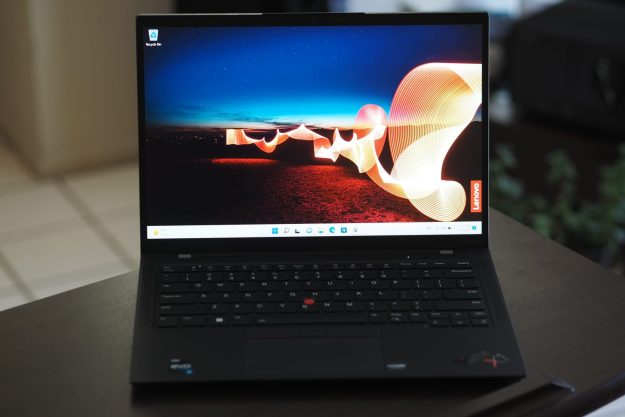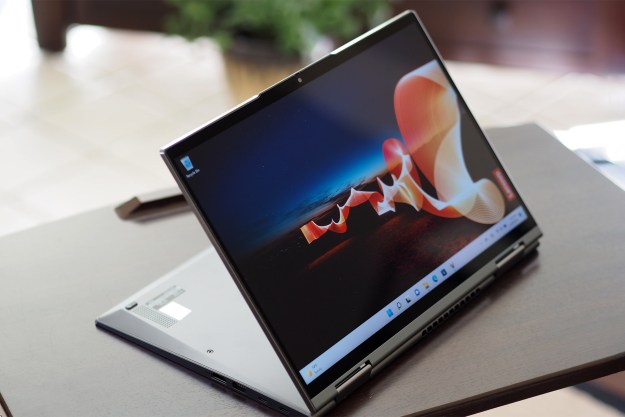
“The Envy 13 is HP’s best 13-inch clamshell laptop, and it’s priced right.”
- Solid productivity performance
- Very good keyboard and touchpad
- Bright and sharp 4K display
- Good looking, mostly modern aesthetic
- Attractive price for a premium laptop
- Thick bezels are an eyesore
- No Thunderbolt 3
The HP Spectre x360 is one of our favorite laptops in the past couple of years, but it’s definitely not a budget device. That’s why HP has the Envy 13. If you’re willing to give up a couple of the non-essential features, it just might be the best option for you.
- An aesthetic that’s all its own
- Finally, a touchpad that doesn’t shame a better keyboard
- A 4K display that’s great for productivity and media binging
- Solid productivity performance — once it’s updated
- Entry-level gaming is possible, but still a bit underwhelming
- As expected, 4K takes a toll on battery life
- Our Take
We evaluated a high-end configuration of the Envy 13, with an 8th-gen Whiskey Lake Intel Core i7-8565U, 16GB of
At $1,200 for the decked-out configuration, the Envy 13 offers a nice set of specifications for a price that barely breaks into premium territory. Does it offer enough to make it a better value than slightly more expensive
An aesthetic that’s all its own
Essentially, the Envy 13 is HP’s entry-level premium laptop. It’s a step down from the Spectre line, but it’s not meant to be merely a budget machine. Accordingly, it’s premium aesthetic does not attempt to mimic its more expensive siblings. At least, not the most recent versions — the Envy 13’s Natural Silver chassis (Rose Gold is an option) has a mix of sharp angles and slight curves that better resembles the previous Spectre generation than the newest gem-cut models. Versions with stunning wood trim underneath the keyboard are coming in the fall, and so stayed tuned.
Overall, we like the look, considering it more understated than today’s Spectre but modern enough – though largely unchanged from its predecessor – to warrant its price. Generally, it rivals the Dell XPS 13 and Asus ZenBook 13 UX333 in its overall aesthetic. It’s when we consider the Envy 13’s build quality that we start to pick some nits – the lid and keyboard deck are just a bit too flexible, although the bottom of the chassis is plenty rigid. The Spectre x360 13, XPS 13, and ZenBook 13 are all more solid machines.
Another point of contention for some people will be the Envy 13’s size. HP hasn’t embraced the tiny bezel movement as have some other vendors, particularly Dell, Asus, and Lenovo (with its IdeaPad S940 in particular). The Envy 13’s side bezels are reasonably thin, but the top and bottom bezels are larger than many recent competitors – creating an 80.92 percent screen-to-body ratio compared to well over 90 percent in the Asus ZenBook S13 and the IdeaPad S940.
As we noted with the Lenovo ThinkPad x390, the Envy 13’s bezels – and overall size – don’t make it more difficult to use in any particular circumstances. It’s not an incredibly small laptop, but it’s small enough. Even so, it’s not going to please anyone who prefers their
The Envy 13’s premium aesthetic makes no attempt to mimic its more expensive siblings.
So, how do those bezels affect the Envy 13’s size? Simply put, its chassis is noticeably larger than its competition in terms of its depth, where the XPS 13 is half an inch smaller and the ZenBook 13 is almost a full inch more svelte. Thanks to its smaller side bezels, the Envy 13 is much closer in width, and it’s slightly lighter than both of its competitors. In terms of thickness, it comes in at 0.57 inches, so it’s right in between the XPS 13’s 0.46 inches and the ZenBook 13’s 0.67 inches.
The Envy 13 has limited connectivity, with one USB-C 3.1 Gen1 port, two USB-A 3.1 Gen1 ports (with a flip-down design necessitated by the angled chassis bottom), and a microSD card reader. That’s one important area of distinction from the Spectre x360 13 – there’s no Thunderbolt 3 support, and so external displays will be more limited and external GPU’s aren’t an option. Wireless connectivity is strong with gigabit 2X2 MU-MIMO Wi-Fi and Bluetooth 5.0 thanks to the latest Intel combo chip. You can charge via either the 65-watt proprietary charger or USB-C.
Finally, a touchpad that doesn’t shame a better keyboard
The Envy 13’s keyboard looks a lot like the Spectre x360 13’s. It’s an island keyboard with silver keys and black lettering, and its backlight is functional with two useful brightness levels. However, we found the Envy 13’s version to have a different feel from the Spectre’s – it’s not quite as deep, and it’s a bit stiffer. That makes it a very good keyboard for long typing sessions, but it’s just a tiny bit behind the Spectre and XPS 13 keyboards in overall comfort. We’ll also note that the space bar is quieter on the Envy 13 than the Spectres.

The touchpad is a revelation, though, relative to the Spectre x360 13. Finally, HP has switched from Synaptics to Microsoft Precision touchpad drivers, and it’s a game-changing improvement. The Envy 13’s touchpad is the same size and wide format as the Spectre’s, but its Windows 10 multitouch gesture support is much smoother and more precise. HP finally has a touchpad that’s the equal of other modern Windows 10
HP finally has a touchpad that’s the equal of other modern Windows 10
Windows 10 Hello password-less login support is provided by a fingerprint reader that, like the most recent Spectre
HP did, though, carry over one attractive feature from the Envy 13’s more expensive siblings: The same toggle that switches off the webcam for enhanced security. It works exactly the same way as on the Spectres – flip the switch off and the webcam disappears from the system completely. It’s a nice solution that completely removes one vector of attack on user privacy.
A 4K display that’s great for productivity and media binging
The Envy 13 has three display options, including both touch and non-touch Full HD (1,920 x 1,080) and a
Our colorimeter rated the display as brighter than average at 369 nits (300 nits is our preferred minimum) and with an average contrast ratio of 820:1 (the best displays are at 1000:1 or better). That’s comparable to most other premium displays, with the
Colors were also average, at 72 percent coverage of the AdobeRGB color space and 94 percent of sRGB. Accuracy was very good at 1.48 (less than 1.0 is considered excellent), and gamma was perfect at 2.2, meaning photos and video won’t be too light or too dark. Most premium 13.3-inch

Subjectively, this is a great display for productivity work, particularly if you don’t like to see pixels and all your applications work well at such a high resolution. It’s also a great display for Netflix video, with the ability to stream
Audio is provided by the usual Bang & Olufsen-tuned system, with quad speakers and a smart amplifier. Volume was plenty loud with only minimal distortion at full strength, and nice mids and highs. Bass was lacking, and so you’ll want to watch your action movies and listen to your tunes with a nice set of
Solid productivity performance — once it’s updated
Our review Envy 13 was built around the 8th-gen quad-core Core i7-8565U. That’s a fast CPU that’s also efficient, and it’s performed well on most systems we’ve tested.
When we first ran our benchmarks, the Envy 13 fell significantly behind the pack. We checked with HP, however, and they sent us new firmware that made a significant difference in the laptop’s performance.
First, the Envy 13 scored well in the Geekbench 4 synthetic benchmark, achieving 5,252 in the single-core test and 15,965 in the multi-core test. That’s second-fastest among our comparison group, with only the Lenovo ThinkPad X390 being faster.
In our real-world Handbrake test, which encodes a 420MB video as H.265, the Envy 13 completed the process in 288 minutes. That’s not particularly fast compared to similar
However, things look a lot better if you open HP’s Command Center software and toggle from “HP Recommended” to “Performance” mode. We did just that, and the Envy 13 completed the test in a very fast 226 seconds – one of the fastest scores we’ve seen for a 15-watt Core i7. Our suspicion is that HP does its best to keep the laptop cool and quiet in “HP Recommended,” while giving the option for an extra boost of performance – and it works.
The Envy 13 is a quick laptop that will keep up with all your productivity tasks and provide a decent boost of power on demand.
Of course, if you use a a creative application that supports the MX250 then you’ll get better-than-integrated graphics performance for these kinds of tasks. That gives the Envy 13 a leg up on most of its 13-inch competition.
In terms of storage, the SK Hynix 512GB PCIe SSD was a little slower than average for a solid-state drive. Looking at the CrystalDiskMark 6 benchmark, the Envy 13 managed 534 megabytes per second (MB/s) in the 4KiB Q8T8 read test and 263 MB/s in the write test. Only the Acer Swift 3 14 with its Kingston 256GB SSD was slower.
The Envy 13 is, overall, a very quick laptop that will keep up with all your productivity tasks and provide a decent boost of power on demand. And while its fans were never unreasonably loud under load – unless HP Command Center is in Performance mode – and shut off when they should, the chassis did get a bit warm. It hit a toasty 112 degrees F on the chassis bottom during a strenuous workout and 107 deg F at the top of the keyboard – we’d like to see these numbers at 100 degrees F or less. One benefit: The angled keyboard deck keeps the bottom of the chassis away from direct contact with the skin.
Entry-level gaming is possible, but still a bit underwhelming
HP equipped the Envy 13 with the entry-level Nvidia GeForce MX250 GPU. This is an update to the popular MX150 GPU, but in our testing provides relatively modest performance improvements.
Our benchmarks showed the Envy 13 to be a solid performer given the GPU. In the 3DMark Fire Strike test, the Envy 13 managed a score of 2,714, which is higher than the Asus ZenBook S13 with its MX150 at 2,650. In Fortnite, the Envy 13 was again competitive, at 34 frames per second (FPS) in 1080p and high graphics and 31 FPS with graphics set to Epic. The ZenBook S13 managed 32 FPS and 29 FPS, respectively, making it slightly slower.
You can do some light gaming on the Envy 13 for sure. Stick to older titles, esports, and keep the resolution and graphical detail turned down on more modern games, and you’ll enjoy the experience.
As expected, 4K takes a toll on battery life
The Envy 13 has 52 watt-hours of battery inside, which doesn’t lead the class. The Spectre x360 13, for example, has 61 watt-hours while the XPS 13 has an identical 52 watt-hours. Given the CPU and the
In our most demanding Basemark web benchmark, the Envy 13 lasted for roughly three and a half hours. That’s about 40 minutes better than the
Next, we ran through a series of popular web sites until the battery ran out, and the Envy 13 managed just under six and a half hours. That’s about half an hour less than the XPS 13
If you want all-day battery life, then the
Our Take
The Envy 13 does well in bringing some of the best features of the Spectre line to a lower price point. In fact, the Spectre 13 clamshell hasn’t been updated in quite some time and isn’t even listed on HP’s website – making the Envy 13 the best 13.3-inch consumer laptop that HP makes that isn’t a 2-in-1. It has solid performance, can do some light gaming, and doesn’t compromise too much on battery life when equipped with a very nice
Is there a better alternative?
The Asus ZenBook 13 UX333FA is a clear alternative. It has a slower CPU that still provides competitive performance out of the box, and its battery life benefits from a Full HD display that’s also better than many premium panels. It’s economical as well, at $850 – but that nets you a lower configuration with a Core i5-8265U, 8GB of
The Dell XPS 13 is another challenger, with similar performance, better build quality, and a concomitant higher price. You’ll spend $1,749 ($1,519 on sale) for the same Core i7, 16GB of
Finally, if you want to hold onto that discrete GPU and would like to get a 13.9-inch display in a smaller chassis, then the Asus ZenBook S13 UX392FN is a good option. It has a more solid build quality, a very nice Full HD display, and great performance. You’ll pay a bit more, though, at $1,400 for a Core i7, 8GB of
How long will it last?
The HP Envy 13 doesn’t feel quite as robust as its most expensive competition, but it’s solid enough to evoke confidence that it will last as long as you need. The 1-year warranty is industry-standard, and disappointing as always.
Should you buy it?
Yes. The Envy 13 provides an attractive combination of good looks, performance, and price.
Editors' Recommendations
- Best HP laptop deals: Get a 17-inch workhorse for $270 and more
- The best HP laptops in 2024
- This midrange HP laptop beats the Dell XPS 15 in one important way
- Why the Dell XPS 13 Plus still beats the latest competition in little laptops
- Yet another disappointment about Intel’s next chips may be true






